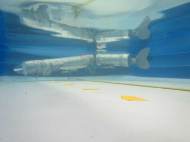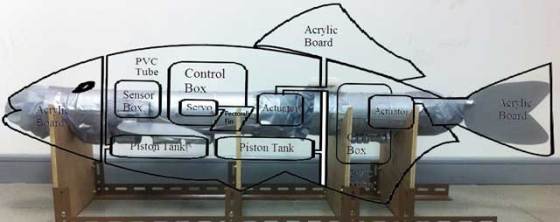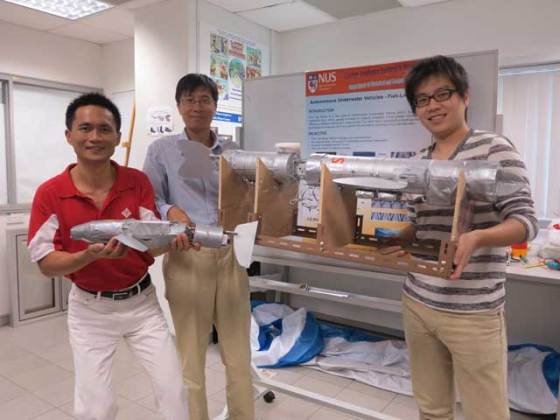Autonomous underwater vehicle swims like a carp
 A team of researchers at the National University of Singapore (NUS) has developed a robot fish that mimics the movements of a carp. Since it can be programmed to perform specific functions, this autonomous underwater vehicle (AUV) could be used for various applications, ranging form underwater archaeology and environment monitoring, to military activities and placement of communication cables.
A team of researchers at the National University of Singapore (NUS) has developed a robot fish that mimics the movements of a carp. Since it can be programmed to perform specific functions, this autonomous underwater vehicle (AUV) could be used for various applications, ranging form underwater archaeology and environment monitoring, to military activities and placement of communication cables.
Mr Fan Lupeng, graduating Electrical Engineering student and Research Fellow, studied the movements of real life carps for three months, in order to develop the robot. Since there is no literature at all on designing a mathematical model on the locomotion of fish, the researchers had to start from scratch.
They used a camera to capture all the possible movements of a carp and then converted the data mathematically in order to transfer the locomotion of a real carp onto the robot. This has been most challenging as fish use a lot of different muscles to move, and many actuators are required to enable the robot to move in the same manner.
The team constructed two versions of the carp inspired robot. The larger prototype is about 1.5 meters (5 feet) in length, weighing about 10kg (22 pounds), while the smaller version of the robot is about 60 cm (2 feet) long and weighs a mere 1.5kg (3.3 pounds). The smaller robot can only swim on water surface is developed for investigation of 2D motion control and motion planning in a small place, while the larger version can dive to a depth of 1.8 meters.
Other challenges included waterproofing the fish body, the motor and the control box. The fins and tails also need to be flexible and the team decided to use very fine (1mm) acrylic board for these. Buoyancy and balance for the robot is maintained by using plastic foams attached to both sides. For the diving mechanism, their robot fish is equipped with an internal ballast system to change density. The system is sophisticated enough to enable the fish to dive suddenly, as well as to the precise depth intended.
“Some fish can achieve almost 180 degree turning in a small turning radius through bending their body while traditional underwater vehicles have a much larger turning radius. Hence it is quite a feat for us to achieve this movement in our robot fish”, said Dr Ren Qinyuan. “To my knowledge, the world’s smallest fish robot is one about 12.7 centimetres (5 inches) in length. It was designed by MIT for specific military purpose and could go to a depth of 1.5 meters.”
Aside being more agile and often more energy efficient, fish robots are also quieter than traditional AUVs. The fact they are smaller than submarines and can be fully autonomous makes these underwater robots ideal to perform many difficult and dangerous tasks. These robots can be used to exploring nooks and corners of wreckage, or sunken cities which are difficult for divers or traditional AUVs to access.
“Compared to traditional AUVs, they are certainly more mobile, with greater maneuverability. If used for military purpose, fish robots would definitely be more difficult to detect by the enemy”, said Xu Jianxin, Professor at NUS’s Department of Electrical & Computer Engineering.
NUS research team hopes to make their robot fish even smaller and more realistic. According to Mr Fan, they intend to equip it with more sensors like GPS and video camera to improve the autonomous 3D movement of the robot and enable more challenging tasks such as object detection.











Leave your response!